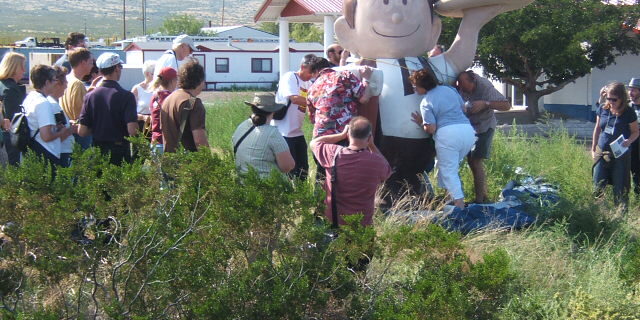In search of vintage motels, diners, curio shops, neon signs, and other roadside artifacts, members of the Society for Commercial Archeology came together in Albuquerque Sept. 10-13 for four days of exploring, touring, learning, and just plain fun.
The theme of this year’s conference was “Southwest Detours: Roadside Culture of New Mexico.” “New Mexico holds special interest to our organization,” said John Murphey, a conference organizer. “Not only is it the home of the oldest road in the United States, but also boasts vivid stretches of Route 66 ways, one-of-a-kind roadside attractions and is at the forefront in recognizing its historic highways and the role of auto tourism in developing the state.”
The conference kicked off with an opening reception at downtown Albuquerque’s famed KiMo Theater, a 1927 “pueblo deco” landmark that long served as a popular performance venue for such stars as Gloria Swanson, Ginger Rogers, Vivian Vance, and fan dancer Sally Rand. The KiMo was saved from being razed for a parking lot in 1977, and the theater’s elaborate Native American ornamentation was beautifully restored in 2000. The reception included a silent auction featuring works by Arizona roadside artist Warren Anderson and Colorado photographer Martin Garfinkel.
 SCA conferences are known for getting members out on the road to experience and explore the commercial environment up close. On Thursday, members traveled by bus along Route 66 from Albuquerque to Gallup, including stops at Dead Man’s Curve, neon signs in Grants, trading posts in Gallup, and lunch at the “Home of the Movie Stars,” the 1936 El Rancho, whose guest list has included such Hollywood notables as Spencer Tracy, Katharine Hepburn, Humphrey Bogart, and Errol Flynn (who is reputed to have rode his horse into the bar).
SCA conferences are known for getting members out on the road to experience and explore the commercial environment up close. On Thursday, members traveled by bus along Route 66 from Albuquerque to Gallup, including stops at Dead Man’s Curve, neon signs in Grants, trading posts in Gallup, and lunch at the “Home of the Movie Stars,” the 1936 El Rancho, whose guest list has included such Hollywood notables as Spencer Tracy, Katharine Hepburn, Humphrey Bogart, and Errol Flynn (who is reputed to have rode his horse into the bar).
On Saturday, a bus tour along old Route 60 spanned three centuries of history. Stops included Mountainair where conferees will enjoy lunch at Pop Shafer Hotel, Restaurant and Curio Shop; then travel 65 miles southwest to visit Socorro’s old plaza, southwestern trading posts and roadside produce stands.
Friday night, fans of vintage neon joined local architect and city historic preservation planner Ed Boles for a walking tour of the city’s Nob Hill area. This tour along Route 66 started at the De Anza Motor Lodge, now owned by the city of Albuquerque. During the walk, SCA members had an opportunity to learn about the potential adaptive reuse of the De Anza and other historic motels along Route 66.
 The conference included a symposium and paper session at Albuquerque’s Hotel Blue, which served as conference headquarters. Presentations covered a wide range of topics related to roadside culture and history, including Phillips 66 service stations, Las Vegas wedding chapels, the architecture of rest stops, roadside neon in New Mexico, and the Mojave River Corridor of U.S. Route 66.
The conference included a symposium and paper session at Albuquerque’s Hotel Blue, which served as conference headquarters. Presentations covered a wide range of topics related to roadside culture and history, including Phillips 66 service stations, Las Vegas wedding chapels, the architecture of rest stops, roadside neon in New Mexico, and the Mojave River Corridor of U.S. Route 66.
The approximately 100 SCA conference attendees arrived from more than 20 states across the U.S., as well as England and Canada. SCA members come from a wide variety of backgrounds and include architects, historians, artists, collectors, teachers, archivists, writers, planners, motel owners, diner operators, and others with an interest in and enthusiasm for the American roadside.
Check out one of the tour guides from this trip here!


